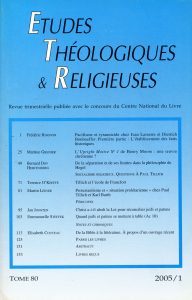Au regard des nombreux textes bibliques qui présupposent que Dieu se laisse voir – même si cette vision advient sub contrario -, faut-il maintenir, dans le contexte d’une théologie biblique, que Dieu est, en soi, théoriquement, invisible ? L’interdit même de le représenter n’est-il pas plutôt un indice de sa visibilité ? Après avoir relevé l’importance du voir dans l’AT, Jean M. Vincent esquisse tout d’abord la problématique de la vision en particulier comme mode de révélation (connexion entre regard et apparition, difficulté de parler de ce qui implique rapture et rupture, importance des horizons d’attente et d’expérience). Il étudie ensuite, dans cette perspective, trois textes de l’AT (Gn 1, Ps 93, Dt 4,9s) avec leurs échos thématiques dans le NT (Jn 1, Col 1,15-20, 2 Co 4,6), pour aboutir à montrer qu’une « texture imaginative » nourrit l’horizon d’attente et rend possible la participation à l’expérience visionnaire, car cette dernière, au fond psychologiquement inaccessible dans son individualité, agit comme une puissante force intégrative pour le cercle des disciples, ce qui se reflète dans la formation de livres comme ceux d’Amos, d’Ézéchiel ou d’Ésaïe. Après la conclusion, est proposé un excursus sur la question controversée de l’aniconographie.
Looking at the numerous biblical passages which presuppose that God lets himself see even if this vision happens sub contrario should we keep upright, in the context of a biblical theology, that God is in himself, theoretically, invisible ? Is not the interdiction as such to represent him an indication of his visibility ? After he has pointed out the importance of seeing in the Old Testament, the author sketches first the problems related to the vision as a mode of revelation (the connection between looking and appearing, the difficulty of speaking of an experience that implies rapture und rupture, the importance of the horizons of expectancy and experience). He studies then in this perspective three passages of the Old Testament (Gn 1, Ps 93, Dt 4/9s) with their thematic echos in the New Testament (Jn 1, Col 1,15-20, 2 Cor 4,6), to lead to a chapter of synthesis in which he shows that an « imaginative texture » nurtures the horizon of expectancy and makes possible an involvment in the visionary experience, for, if, in its individuality, such an experience remains psychologicaly inaccessible, it works as a mighty integrating force for the circle of disciples, as this is reflected in the formation of books like those of Amos, Ezekiel and Isaiah. After a short conclusion, the author presents an excursus on the highly debated question about aniconography.
p. 1-23
Auteur
VINCENT Jean Marcel
Jean Marcel VINCENT (1945-2022) a été professeur d'Ancien Testament de l'Institut protestant de théologie, Faculté de Paris.
